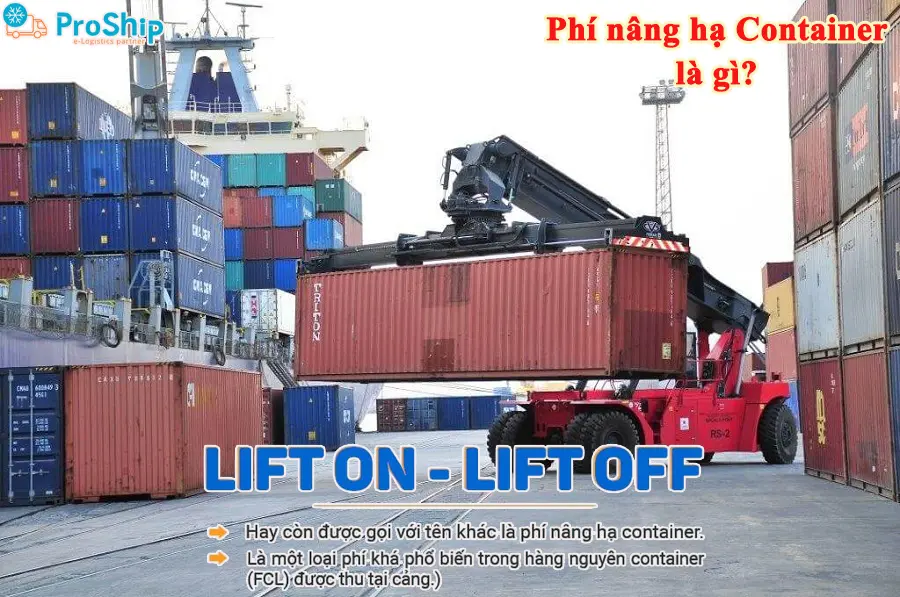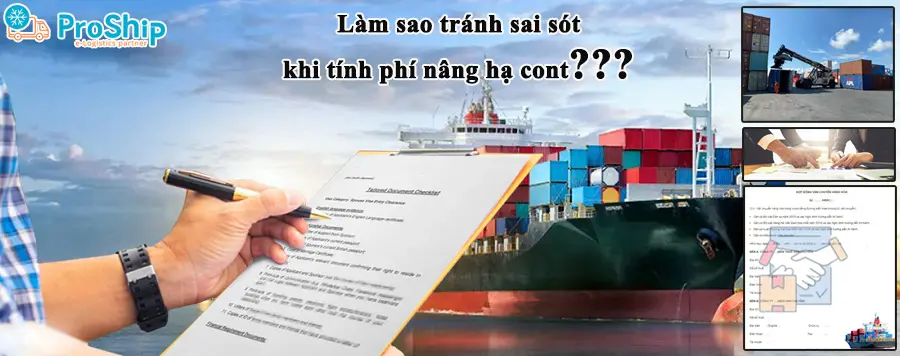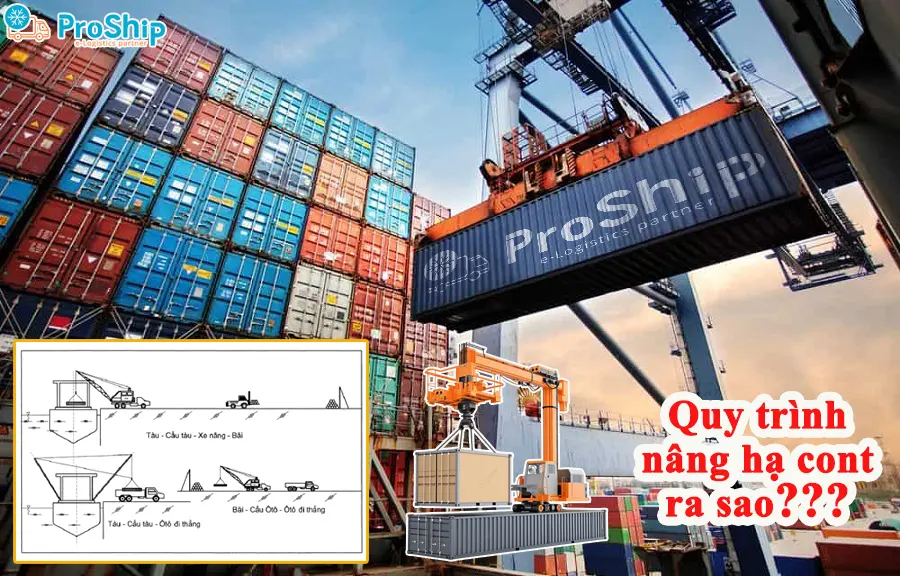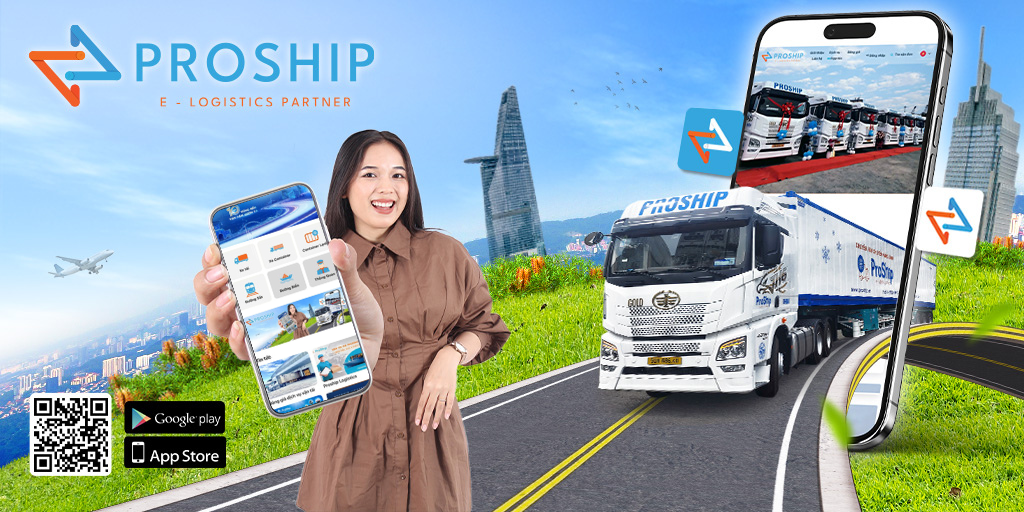Nhiều chủ hàng, doanh nghiệp XNK còn thắc mắc về khoản phí nâng hạ cont là gì? Bên nào phải chịu trả phí này, có gì khác so với phí THC? Bạn chưa biết đâu là các yếu tố ảnh hưởng tới phí nâng hạ cont này? Và doanh nghiệp bạn cần tìm hiểu chi tiết quy trình nâng cont, hạ cont tại cảng biển được tiến hành ra sao?
Sau đây, Proship.vn chúng tôi sẽ giúp bạn hiểu rõ phí nâng hạ container là gì, bên nào phải chịu thanh toán khoản phí nâng cont và phí hạ cont, quy trình các bước nâng hạ cont thế nào, yếu tố nào ảnh hưởng tới phí nâng hạ cont,…
Phí nâng hạ cont là gì?
Phí nâng hạ container là gì? Phí nâng hạ container còn gọi là Lift on – Lift off fee (Lo-Lo), là một khoản phí mà cảng sẽ thu từ chủ hàng trong quá trình làm thủ tục thông quan. Chi tiết về phí nâng hạ container:
Lift On (Phí nâng container)
Là phí trả cho việc sử dụng các thiết bị như cần cẩu hoặc máy nâng để đưa cont lên phương tiện vận tải (xe tải, tàu). Phí này được tính khi cont được đưa từ mặt đất hoặc từ bến cảng lên xe tải, tàu hoặc các phương tiện khác.

Lift Off (Phí hạ container)
Là phí trả cho việc hạ container từ phương tiện vận tải xuống mặt đất hoặc khu vực lưu trữ tại bến cảng. Phí này được tính khi container được hạ từ tàu xuống bến cảng hoặc từ xe tải xuống bãi lưu trữ.
Vậy, bên nào chịu mức phí này? Thông thường, CHỦ HÀNG sẽ phải thanh toán khoản phí này trực tiếp tại cảng hoặc thông qua đơn vị giao nhận (Forwarder) khi tiến hành thủ tục hải quan.
Yếu tố ảnh hưởng đến phí nâng hạ container
Yếu tố ảnh hưởng tới phí nâng hạ container là gì? Đó là các yếu tố bao gồm khách quan và chủ quan, cụ thể:
Yếu tố khách quan tác động đến phí nâng hạ cont
Các yếu tố khách quan tác động tới phí nâng hạ cont:
- Tình trạng giao thông tại cảng: Tắc nghẽn giao thông, tình trạng bến bãi, và thời gian chờ đợi cũng có thể ảnh hưởng đến phí nâng hạ;
- Quy định của cảng: Mỗi cảng sẽ có quy định về mức phí khác nhau dựa trên cơ sở hạ tầng, thiết bị sử dụng và các dịch vụ đi kèm;
- Thị trường cung cầu: Nếu nhu cầu nâng hạ container cao và thiết bị, nhân công có hạn, phí nâng hạ có thể tăng lên.
Yếu tố chủ quan tác động đến phí nâng hạ cont
Các yếu tố chủ quan tác động tới phí nâng hạ cont:
- Khối lượng và kích thước container: Container nặng hơn hoặc có kích thước đặc biệt có thể yêu cầu thiết bị nâng hạ chuyên dụng và sẽ có mức phí cao hơn;
- Loại hàng hóa: Hàng hóa nguy hiểm, hàng lạnh hoặc các loại hàng hóa đặc biệt sẽ yêu cầu mức phí nâng hạ cao hơn do yêu cầu về an toàn và thiết bị chuyên dụng;
- Yêu cầu về thời gian: Yêu cầu nâng hạ nhanh chóng hoặc ngoài giờ hành chính có thể dẫn đến việc tăng phí.
Cách tránh sai sót khi tính phí nâng hạ container
Nhiều chủ hàng, doanh nghiệp thắc mắc liệu có hay không cách tranh sai xót khi tính phí nâng hạ container là gì? Proship xin chia sẻ vài cách sau:
Lưu giữ đầy đủ giấy tờ và chứng từ
Đảm bảo lưu giữ tất cả các giấy tờ liên quan như hóa đơn, biên lai, phiếu xác nhận nâng hạ container, hợp đồng dịch vụ để có thể đối chiếu và giải quyết các tranh chấp (nếu cần).
Kiểm tra kỹ hợp đồng và hóa đơn dịch vụ
Đọc kỹ các điều khoản trong hợp đồng dịch vụ nâng hạ để hiểu rõ các loại phí và phương thức tính phí. Đối chiếu với hóa đơn để đảm bảo không có khoản phí nào bị tính sai hoặc tính thừa.

Xác nhận lại với Nhà cung cấp dịch vụ
Trước khi thanh toán, nên liên hệ với nhà cung cấp dịch vụ để xác nhận lại các khoản phí và yêu cầu giải thích rõ ràng nếu có điểm nào không rõ ràng hoặc có dấu hiệu sai sót.
Sử dụng phần mềm hoặc công cụ quản lý chi phí
Sử dụng các phần mềm hoặc công cụ quản lý chi phí logistics có thể giúp tự động hóa việc tính toán, ghi nhận chi phí và kiểm tra sai sót, đảm bảo tính chính xác và minh bạch.
Quy trình các bước nâng hạ container ra sao?
Quy trình nâng hạ container gồm các bước sau:
Bước 1: Kiểm tra và xác nhận thông tin cont
Trước khi nâng hạ cont, nhân viên cảng sẽ kiểm tra và xác nhận thông tin container, gồm loại container, tình trạng, khối lượng và vị trí hiện tại. Việc kiểm tra này giúp đảm bảo rằng container đáp ứng các tiêu chuẩn an toàn và chuẩn bị cho việc di chuyển.
Bước 2: Chuẩn bị thiết bị và vị trí
Các thiết bị nâng hạ như cần cẩu hoặc xe nâng container được chuẩn bị sẵn sàng và di chuyển đến vị trí container cần nâng hạ. Vị trí nâng hạ cũng được làm sạch và đảm bảo không có chướng ngại vật.
Bước 3: Nâng cont lên thiết bị vận tải
Với việc nâng container từ mặt đất lên phương tiện vận chuyển (tàu, xe tải, tàu hỏa), cần cẩu hoặc xe nâng container sẽ tiếp cận và kẹp chắc container. Container sau đó được nâng lên cẩn thận để đảm bảo an toàn, tránh rung lắc hoặc nghiêng đổ.
Bước 4: Di chuyển cont đến vị trí đích
Sau khi container được nâng lên, thiết bị nâng hạ sẽ di chuyển nó đến vị trí đích như trên boong tàu, trên bãi container, hoặc trên xe tải. Trong quá trình di chuyển, cần đảm bảo container được giữ vững và không lắc lư, đảm bảo an toàn cho người điều khiển thiết bị và container.

Bước 5: Hạ cont xuống vị trí đích
Khi container đã đến vị trí đích, thiết bị nâng hạ sẽ hạ container xuống một cách từ từ và cẩn thận để tránh va chạm hoặc đổ vỡ. Sau khi hạ xuống vị trí chính xác, container sẽ được tháo kẹp và kiểm tra lại lần cuối để đảm bảo an toàn và đúng vị trí.
Bước 6: Kiểm tra sau nâng hạ
Sau khi hoàn thành quá trình nâng hạ, nhân viên cảng sẽ tiến hành kiểm tra lại container, xác nhận rằng container đã được đặt đúng vị trí và không có hư hại xảy ra trong quá trình di chuyển.
Bước 7: Hoàn tất thủ tục giấy tờ
Hoàn tất các thủ tục giấy tờ cần thiết, bao gồm việc ký nhận và ghi nhận thông tin vào hệ thống quản lý của cảng hoặc bãi container.
Phí nâng hạ container là gì cùng những kiến thức liên quan đã được chuyển tải bởi Proship. Có thể nói, phí nâng hạ container (Lift on – Lift off) chính là một phần không thể thiếu trong quá trình vận chuyển hàng hóa bằng container.
Do đó, việc hiểu rõ phí này sẽ giúp tối ưu chi phí nâng hạ, từ đó giúp doanh nghiệp tiết kiệm phí vận chuyển và nâng cao hiệu quả trong chuỗi cung ứng logistics…Để được tư vấn các giải pháp vận chuyển hàng Đa phương thức giá rẻ, liên hệ ngay 0909 344 247.

